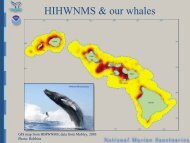The First International Conference on Marine Mammal Protected Areas
The First International Conference on Marine Mammal Protected Areas
The First International Conference on Marine Mammal Protected Areas
Create successful ePaper yourself
Turn your PDF publications into a flip-book with our unique Google optimized e-Paper software.
Improving MPAs and MPA networks – a New Zealand perspective<br />
Mike D<strong>on</strong>oghue<br />
Fifty species of marine mammals are recorded from New Zealand waters – two of them<br />
endemic. Many species are of cultural as well as scientific significance. C<strong>on</strong>sequently,<br />
New Zealanders generally support marine mammal c<strong>on</strong>servati<strong>on</strong>. <strong>Marine</strong> mammals in<br />
New Zealand are exposed to the same suite of threats found elsewhere in the world’s<br />
oceans – fishery interacti<strong>on</strong>s, ship strikes, marine debris, etc. Various Acts of Parliament<br />
(including the <strong>Marine</strong> <strong>Mammal</strong>s Protecti<strong>on</strong> Act, 1978) and government policies provide<br />
the framework for managing marine mammals in New Zealand, and this involves several<br />
government agencies, regi<strong>on</strong>al councils, and local Maori (iwi). Transparency and public<br />
c<strong>on</strong>sultati<strong>on</strong> are facilitated through the publicati<strong>on</strong> of management strategies, such as the<br />
New Zealand Sea Li<strong>on</strong> Populati<strong>on</strong> Management Plan, which is specifically aimed at<br />
developing a strategy to reduce fishing-related mortality of New Zealand sea li<strong>on</strong>s in a<br />
squid trawl fishery around the sub-Antarctic Auckland Islands. Public involvement has<br />
been key to notifying researchers when southern right whales are close enough to the<br />
mainland for photography and biopsy sampling. After a protracted period of public<br />
c<strong>on</strong>sultati<strong>on</strong>, the Ministers of Fisheries and C<strong>on</strong>servati<strong>on</strong> recently announced the<br />
establishment of four new marine mammal sanctuaries, and the expansi<strong>on</strong> of the existing<br />
Banks Peninsula marine mammal sanctuary, to protect endemic Hector’s and Maui’s<br />
dolphins from fishing-related mortality.<br />
Key less<strong>on</strong>s learned from the New Zealand experience are:<br />
• Str<strong>on</strong>g science is essential to underpin management decisi<strong>on</strong>s.<br />
• Engagement of the Ministry of Fisheries is vital for addressing fishery bycatch<br />
issues.<br />
• Stakeholder c<strong>on</strong>sultati<strong>on</strong> and engagement of iwi are essential.<br />
• Public support is indispensable.<br />
• Litigati<strong>on</strong> is always likely <strong>on</strong> fishery-related issues.<br />
• Public awareness and compliance are integral to any c<strong>on</strong>servati<strong>on</strong> strategy.<br />
Using c<strong>on</strong>diti<strong>on</strong> reports to guide management and to track performance in an MPA network<br />
Steve Gittings<br />
NOAA’s Office of Nati<strong>on</strong>al <strong>Marine</strong> Sanctuaries manages 14 marine areas ranging in size<br />
from less than 1 nmi 2 to almost 140,000 nmi 2 , each with its own c<strong>on</strong>cerns and<br />
requirements for envir<strong>on</strong>mental m<strong>on</strong>itoring. A System-Wide M<strong>on</strong>itoring (SWiM)<br />
approach is used to m<strong>on</strong>itor design and reporting in a c<strong>on</strong>sistent manner at multiple<br />
spatial scales and for multiple types of resources – primarily water, habitat, living<br />
organisms, and maritime archaeological assets. <str<strong>on</strong>g>The</str<strong>on</strong>g> sanctuaries prepare “c<strong>on</strong>diti<strong>on</strong><br />
reports” that describe human pressures, address a series of questi<strong>on</strong>s about resource<br />
c<strong>on</strong>diti<strong>on</strong> and trends, and specify management acti<strong>on</strong>s taken in resp<strong>on</strong>se to threats (the<br />
“Pressure-State-Resp<strong>on</strong>se” framework). <str<strong>on</strong>g>The</str<strong>on</strong>g> questi<strong>on</strong>s posed within the m<strong>on</strong>itoring<br />
framework provide a tool by which the program can measure progress toward the<br />
maintenance and improvement of natural and archaeological resource quality throughout<br />
the system. <str<strong>on</strong>g>The</str<strong>on</strong>g> c<strong>on</strong>diti<strong>on</strong> reports also help set the stage for management plan reviews at<br />
ICMMPA <str<strong>on</strong>g>C<strong>on</strong>ference</str<strong>on</strong>g> Proceedings<br />
53



